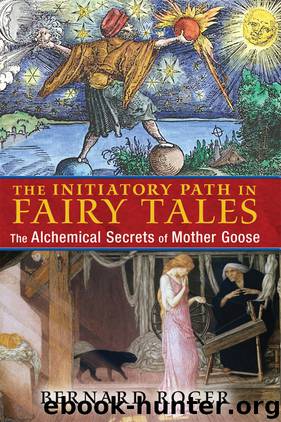The Initiatory Path in Fairy Tales by Bernard Roger

Author:Bernard Roger
Language: eng
Format: epub
Tags: Spirituality/Literature
Publisher: Inner Traditions/Bear & Company
Published: 2015-05-22T04:00:00+00:00
FOUR ESSENTIAL FACTORS OF FATE
In each of these tales, the hero’s fate is linked to four essential factors: the party responsible for his departure on a quest, the assistants that allow him to reach this place, the object of the quest, and the place where this object is found.
The Party Responsible for the Departure
In the majority of cases, it is a king who sends the “young man” to find adventure, often his own father when the hero is a prince, or else a slanderer or some shadowy figure: an old queen mother, a jealous servant, or an evil companion met while traveling. But it can also happen that it is the princess who imposes the departure on the individual who desires to win her, or a certain gray man who also tells him what route to follow.
The figure of the king obviously designates a principle of supreme authority. Psychology might see this as the superego on the level of social relations or the id on a spiritual level. In Masonic tradition, it is the “master;” in the material process of the art of Hermes, it is “the sun” or “the king” of the Great Work. The princess is the true object of the quest, and union with her its purpose, and the gray man reappears often in the tales.
Hidden in the bottommost chambers in The Queen Bee, this strange figure also inhabits the forest cottage whose tiny light shines in the depths of the night. Discovered in the muck at the bottom of a bog in the Grimm Brothers’ The Iron Man, he is the guardian of the spring of gold. This gray man is the “servant of the candle” in the Lorraine story also called The Iron Man, in which the soldier La Ramée finds him sitting atop a bronze anvil in the seventh chamber of a castle. In The Griffon, he provides Stupid Hans the means to complete his labors, first by giving the apples in his basket healing powers and to his earthly vessel the power to move “as quick as the wind,” then by giving him a whistle whose sound calls his herd of hares together. This lackluster figure bears a great resemblance, by its color and character, to the rustic Parisian effigy that until the middle of the eighteenth century stood on the western edge of the square in front of Notre Dame, a figure that can be seen today only in several old engravings. Amédée de Ponthieu gave a description of it in his book on the legends of old Paris.
A sacred monolith, which time had rendered shapeless. The ancients called it Phobigenus, the son of Apollo. Later the people called it Maître Pierre, meaning master stone, stone of power. It was also called Messire Legris (Mr. Gray), since gray signified fire and particularly feu grisou (fire damp) and feu follet (will o’ the wisp).22
Download
This site does not store any files on its server. We only index and link to content provided by other sites. Please contact the content providers to delete copyright contents if any and email us, we'll remove relevant links or contents immediately.
Animal Frequency by Melissa Alvarez(3749)
Sigil Witchery by Laura Tempest Zakroff(3647)
Real Magic by Dean Radin PhD(3562)
Fingerprints of the Gods by Graham Hancock(3206)
The Rosicrucians by Christopher McIntosh(3044)
Aleister Crowley: The Biography by Tobias Churton(3015)
Journeys Out of the Body by Robert Monroe(2980)
Alchemy and Alchemists by C. J. S. Thompson(2907)
Mysteries by Colin Wilson(2883)
Hitler's Monsters by Eric Kurlander(2727)
John Dee and the Empire of Angels by Jason Louv(2705)
Wicca: a guide for the solitary practitioner by Scott Cunningham(2702)
Infinite Energy Technologies by Finley Eversole(2486)
The Hatha Yoga Pradipika (Translated) by Svatmarama(2476)
Dark Star Rising by Gary Lachman(2415)
The Book of Lies by Aleister Crowley(2381)
Aliens by Jim Al-Khalili(2376)
To Light a Sacred Flame by Silver RavenWolf(2350)
Hitler's Flying Saucers: A Guide to German Flying Discs of the Second World War by Stevens Henry(2289)
